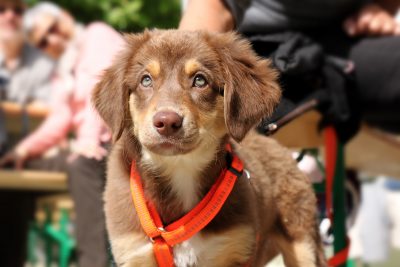Teaching your dog to walk properly on a leash can be a trying experience, but the rewards last a lifetime. Unfortunately, not many dogs naturally know how to properly walk on a leash so this is definitely something that you will need to teach them.
You need to remember that for your dog, going outside is an exciting adventure. Just like a kid in a candy shop, your dog is going to push and pull you in every direction as he takes in his new surroundings. Think of the training process as a learning experience for both you and your pup.
It’s going to take patience, time, and discipline. This might not sound like the most glamorous of times, but hopefully with these dog training tips you’ll be much more at ease when approaching the training process.
Take Things Slow
If you spend a sufficient amount of time getting your dog acquainted with his collar and leash, he will be much more well-behaved when it comes time to take to the streets. An easy way to do this is to gradually introduce your dog to his collar. Have your dog wear his collar around the house for a few hours at a time.
Eventually your dog should become comfortable enough to wear his collar all the time. This should also serve as a precautionary measure should your dog ever run away. If that were to happen, make sure your dog’s collar also has a dog tag on it with your address and phone number.
After your dog has become comfortable wearing his collar, try attaching the leash in your home to start. Let your dog run around with the leash trailing behind him and be sure to reward him with praise and treats.
The reason you should reward this behavior is because you want to teach your dog that “collar and leash time” is something that should excite him. In due time, your dog will want to be in his leash and collar. It’s important in this early stage of training that you don’t try to accelerate the process by holding the leash.
You want your dog to feel in control when they are wearing their leash in order to make them more comfortable and relaxed when it comes time for the real deal.
Teach Your Dog a Cue
The next step in the training process is to develop a cue, or sound, for your dog’s reward. This can be as simple as clicking your tongue, saying “yes,” or “good girl/boy.” The most important part of this step is that your cue remains consistent. The more you interchange sounds and words, the less your dog will understand what you are trying to tell him.
Once you’ve picked a cue that works for you and your dog, place him in a quiet and non-distracting environment. With your dog wearing his collar and leash, stand across the room and use your cue sound. The second your dog turns and looks towards you, reward him with a treat.
Eventually your dog will start to connect this cue sound with a reward, and instead of just looking at you, your dog will come towards you. This is an important step because you don’t want to be chasing your dog around the house in order to get him ready to go outside. Just like the previous step of getting your dog acquainted with his collar and leash, this step furthers the positive experience of wearing his training equipment.
Practice Inside First
Professionals recommend practicing this process inside first as it greatly reduces outside distractions for your dog, including people and other dogs. This allows your dog to give you his full attention, which should speed up the learning process.
Since this process can be a trying experience, keep these training sessions short. If your dog is taking longer than you expected to get used to his leash, don’t force things. Reward small milestones and take sufficient breaks between your training sessions.
Curb Your Dog’s Excitement
Even after first practicing walking inside, it is typically very common for your dog to get excited when you put on his collar and leash. He will likely associate these items with going outside, which is naturally a fun and rewarding experience. If this is something you see happening with your dog, you need to make sure that he is fairly calm before taking him outside.
If your dog is overly excited, you need to be patient and calm him down first. In order to do so, walk towards the door and pick up the leash. If your dog starts racing around, barks, whines, spins, or jumps, do not place the leash on him. Simply stand still doing and saying nothing until your dog starts to calm down.
Once your dog is calm enough, attempt to slowly clip the leash to his collar. If your dog starts to get excited again, quickly pull back the leash to your body without attaching it. Repeat this process until your dog is calm when and after you clip the leash. This can be incredibly tedious, but if you don’t start with this step, things will only escalate once you get outside.
Training Your Dog to Walk Without Pulling
Now that your dog is calm enough to go outside, you can begin to teach him how to properly walk on a leash. The first thing that you want to teach your dog is how to walk on his leash without pulling you. You need to make sure that you control the leash, and not the other way around.
Ways to teach this behavior include rewarding your dog when the leash goes slack and adopting a “no forward progress approach” to pulling. This means that if your dog starts to pull you on the leash, simply stop walking and stand still. Your dog will likely try to keep pulling but will eventually realize you aren’t moving and will turn and face you.
When the leash goes slack again, reward your dog and then continue walking. This will teach your dog that trying to lead will not get them anywhere and will also reinforce positive behavior.
Training Your Dog to Walk By Your Side
Another common issue that you may face during leash training is your dog walking in front, behind, or in circles around you. One way to counteract this behavior is to establish a side that your dog walks on. Traditionally this is your left side, but this can be a matter of preference by the owner.
Regardless of what side you choose to have your dog walk on, keep it consistent so your dog knows where he’s supposed to go. Once you pick a side, start by placing your dog on that desired side and keep the leash short. If your dog is walking comfortably, try loosening the leash a bit.
Continue to reward this positive behavior with treats and praise. Should your dog start to wander to the other side, instead of scolding them or yanking the leash, simply lure them back to the right side with treats.
Limit Distractions
If you see your dog starting to go after something while you’re on a walk, try to redirect his attention as quickly as possible. When you’re first training your dog, you need to be proactive when this happens. When you first begin taking him outside, redirect his attention whenever you see another dog, person, or a car.
You can do this by creating space between you and the target, which could be done by switching the side of the road you’re walking on or changing directions. In addition, distract your dog with a treat to reinforce that staying near you is the proper behavior.
How to Train your Dog to Stop Barking
There’s nothing worse than hearing your dog constantly barking. This behavior can happen indoors and outdoors, but oftentimes dogs bark more frequently when they are in a stimulating environment.
Being outside on the leash for the first time is a new experience for your dog so it’s likely he’ll bark at just about anything. Whether this be another dog, a person, or a car, your dog is encountering things that he hasn’t been around before. As you continue to expose your dog to the outside environment, you should start to see a decrease in this behavior.
Another cause of excessive barking is lack of physical exercise. You want to make sure that your dog is getting a sufficient amount of exercise in order to keep him healthy and to help reducing barking.
Consider playing fetch in the backyard before going on a walk to release some pent-up energy. If it seems like this is turning out to be a hard habit to break, try giving your dog treats as you walk while he isn’t barking. When they do start to bark, stop walking and wait until they stop. When they do, reward your dog with a treat.
Choose the Right Equipment
When you’re first teaching your dog how to walk properly on a leash, you should use a four- to six-foot leash. The width and material is less important than the length, so using whichever you feel most comfortable with is fine.
While extendable leashes and leashes longer than six feet are great for exercising your dog, they don’t work well for initial leash training purposes. Try introducing those leashes once your dog is obedient and well behaved on their shorter leash.
Suitable choices include regular buckle or snap collars, martingale collars (also called a limited slip or greyhound collar), head halter, or a no-pull harness. Head halters and no-pull harnesses can decrease pulling almost completely because they are much more restrictive on your dog.
The only precaution with starting with this form of collar is that your dog will likely only behave well when wearing this particular style. Essentially you aren’t actually teaching them how to properly walk on a leash, you are just limiting his ability to pull you. Therefore, it is recommended that you first use a standard leash to teach your dog proper leash etiquette, then introduce this collar later.
There’s no doubt that leash training is a hard process. In fact, it is a long process and takes patience and commitment. Rushing the process will only cause problems in the future, so it is recommended that you put in the effort early on. It’s much easier to teach your dog a new behavior rather than focusing on fixing a negative one.
Therefore, focus on getting the training right the first time no matter how long it takes. Make the experience positive and rewarding for your dog and he will be much more willing to listen to your commands. Remember, establishing a positive relationship with your dog is the first step to any training success.







